 You know it is the dead of winter in Michigan when the garden is a place to long for from afar. Most of my garden views now are through the windows. Not that I didn’t plan for good views from inside, but the sheer thrill of a landscape is being in it, or experiencing it up close. I would be lying if I said I enjoyed the winter as much as the other three seasons. Ha!~ I hate being cooped up, and I am not a skier or an ice fisherman. Being outside now is a necessity to get from one place to another. I do not walk my garden in the winter. I cannot really explain this, but I do not want to disturb my dormant landscape. In my opinion, the winter is the time to let everything as it is, be. As it is, to see this part of the garden in winter requires gearing up – as in coat, hat, boots and gloves. Today I jump tromped through the snow rather that shoveling the upper deck, to take this picture. Was it worth the effort? But for a gorgeous circa 1920 Jarre de Biot, from the now closed Poterie Provencale that makes my heart beat faster every time I look at it, this scene is not that scenic. A garden growing and representing is a tough act to follow.
You know it is the dead of winter in Michigan when the garden is a place to long for from afar. Most of my garden views now are through the windows. Not that I didn’t plan for good views from inside, but the sheer thrill of a landscape is being in it, or experiencing it up close. I would be lying if I said I enjoyed the winter as much as the other three seasons. Ha!~ I hate being cooped up, and I am not a skier or an ice fisherman. Being outside now is a necessity to get from one place to another. I do not walk my garden in the winter. I cannot really explain this, but I do not want to disturb my dormant landscape. In my opinion, the winter is the time to let everything as it is, be. As it is, to see this part of the garden in winter requires gearing up – as in coat, hat, boots and gloves. Today I jump tromped through the snow rather that shoveling the upper deck, to take this picture. Was it worth the effort? But for a gorgeous circa 1920 Jarre de Biot, from the now closed Poterie Provencale that makes my heart beat faster every time I look at it, this scene is not that scenic. A garden growing and representing is a tough act to follow.
 The best part of it may be the Parrotia Persica. There are four of them in the driveway garden. I planted them close to 20 years ago. This means they are old enough to exhibit that beautiful exfoliating bark prized by gardeners. They also hang on to their leaves throughout all but the windiest of winters. Those copper color leaves are a sight for winter sore eyes.
The best part of it may be the Parrotia Persica. There are four of them in the driveway garden. I planted them close to 20 years ago. This means they are old enough to exhibit that beautiful exfoliating bark prized by gardeners. They also hang on to their leaves throughout all but the windiest of winters. Those copper color leaves are a sight for winter sore eyes.
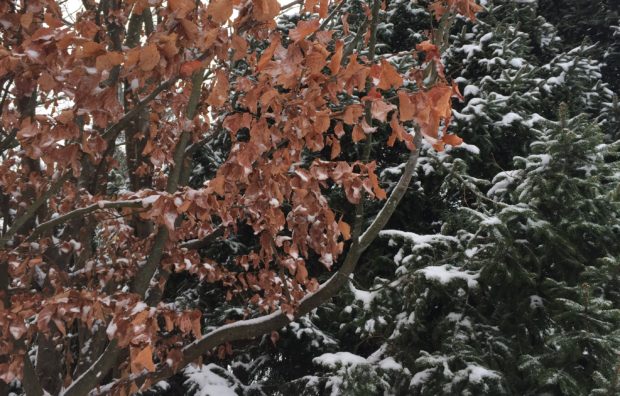 Even these dead leaves look good to me. But the fact of the matter is I am not looking at anything that is dead. Hibernating would be a better and much less emotionally charged word. Every woody plant in my yard grew and set buds for the spring of 2018 last summer. Some buds, on spring flowering trees are flower buds. Smaller buds will surely become leaves once the weather breaks. The dead leaves from 2017 on the parrotias will be pushed off in the spring, when the 2018 leaf buds set in 2017, swell and grow. The parrotias were ready for this winter long before I was.
Even these dead leaves look good to me. But the fact of the matter is I am not looking at anything that is dead. Hibernating would be a better and much less emotionally charged word. Every woody plant in my yard grew and set buds for the spring of 2018 last summer. Some buds, on spring flowering trees are flower buds. Smaller buds will surely become leaves once the weather breaks. The dead leaves from 2017 on the parrotias will be pushed off in the spring, when the 2018 leaf buds set in 2017, swell and grow. The parrotias were ready for this winter long before I was.
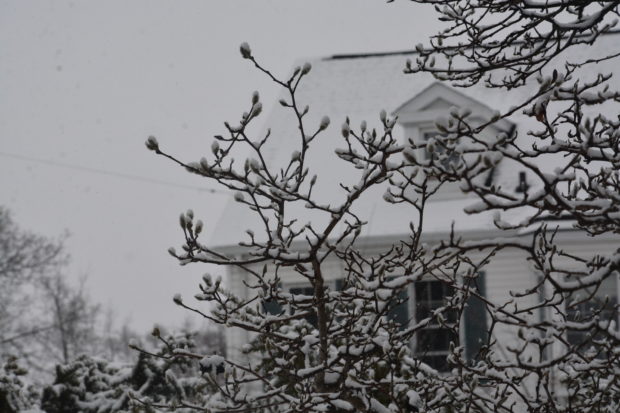 The flower buds on magnolia trees are large and fuzzy. No big fuzzy oval buds on a magnolia going in to winter means there will be no flowers. Terribly cold weather can damage or destroy those flower buds, while the leaf buds survive. A flower bud is a big and vulnerable structure, whereas every tree keeps their leaf buds close to their vest until the winter passes. It is an easy matter to spot magnolia flower buds in winter, especially when a light and dry snow falls. You can see your future in the garden if you see the signs. Happily, I see magnolia flowers in my future.
The flower buds on magnolia trees are large and fuzzy. No big fuzzy oval buds on a magnolia going in to winter means there will be no flowers. Terribly cold weather can damage or destroy those flower buds, while the leaf buds survive. A flower bud is a big and vulnerable structure, whereas every tree keeps their leaf buds close to their vest until the winter passes. It is an easy matter to spot magnolia flower buds in winter, especially when a light and dry snow falls. You can see your future in the garden if you see the signs. Happily, I see magnolia flowers in my future.
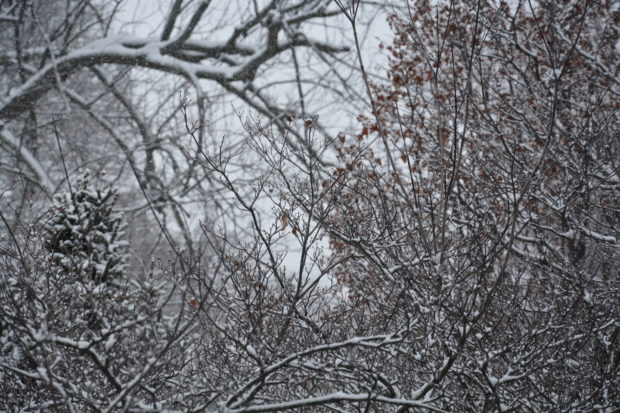 Nature does not wait until the last minute to make a move. As no growth goes on during the winter months, the formation of buds for the spring to come have to be made many months in advance. This is why watering trees and shrubs in August and on through the fall is so important. Once the leaves drop, and the ground freezes, there will be no more activity until the season turns to spring. It only makes sense that the growth of any woody plant instigated by the spring of one year culminates in the readiness for the spring of the following year. This is not in any way magical. It is survival.
Nature does not wait until the last minute to make a move. As no growth goes on during the winter months, the formation of buds for the spring to come have to be made many months in advance. This is why watering trees and shrubs in August and on through the fall is so important. Once the leaves drop, and the ground freezes, there will be no more activity until the season turns to spring. It only makes sense that the growth of any woody plant instigated by the spring of one year culminates in the readiness for the spring of the following year. This is not in any way magical. It is survival.
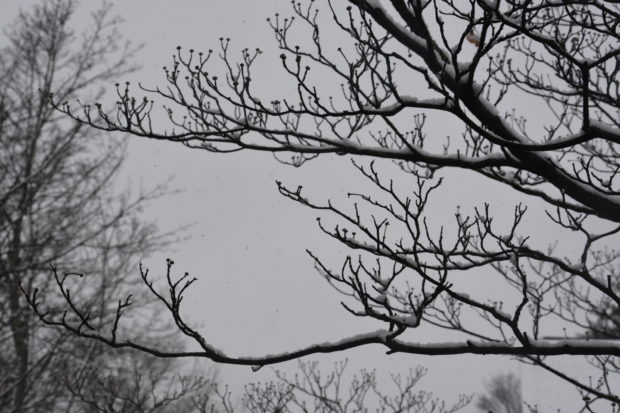 The dogwoods are the easiest to read. The big fat round buds set in September are flower buds. The small pointed buds will eventually unfurl and become leaves. In a way, I regret knowing in advance whether there will be a heavy dogwood bloom 6 months in advance of the fact. But I do like knowing in advance that if I water my trees properly at the time they are setting flower and leaf buds, I am giving them a helping hand.
The dogwoods are the easiest to read. The big fat round buds set in September are flower buds. The small pointed buds will eventually unfurl and become leaves. In a way, I regret knowing in advance whether there will be a heavy dogwood bloom 6 months in advance of the fact. But I do like knowing in advance that if I water my trees properly at the time they are setting flower and leaf buds, I am giving them a helping hand.
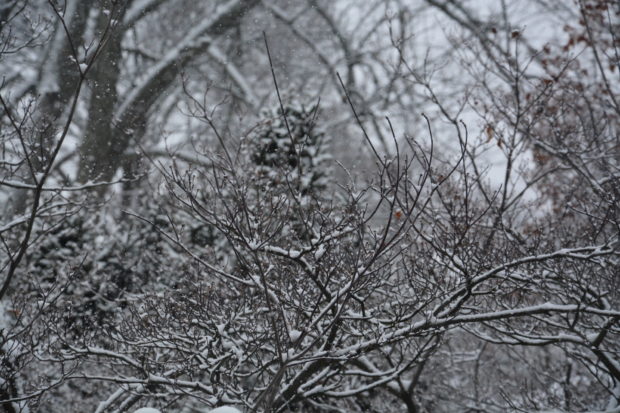 Though it might appear that all there is to see here are sticks and snow, nothing could be further from the truth. Thousands upon thousands of fully formed but dormant buds are ready and waiting for the light to turn green. Imagine that.The spring season every gardener longs for will finally arrive, and will be impossible to keep up with.
Though it might appear that all there is to see here are sticks and snow, nothing could be further from the truth. Thousands upon thousands of fully formed but dormant buds are ready and waiting for the light to turn green. Imagine that.The spring season every gardener longs for will finally arrive, and will be impossible to keep up with.
 The spring is a rush of events almost impossible to keep track of. I am sure there are moments I miss, no matter how much effort I put towards experiencing it all. Today I took note of the columnar fruiting pear tree in the foreground of this picture, and imagined what it will be to see it it in full bloom with the leaf shoots not far behind. I had time for that today. Those flowers in spring will last but a moment.
The spring is a rush of events almost impossible to keep track of. I am sure there are moments I miss, no matter how much effort I put towards experiencing it all. Today I took note of the columnar fruiting pear tree in the foreground of this picture, and imagined what it will be to see it it in full bloom with the leaf shoots not far behind. I had time for that today. Those flowers in spring will last but a moment.
 I also had time to think about how nature is a consummate engineer. Very little of the story of survival is left to chance. That is a big topic best left to the dog days of winter to think about. All the bare branches outlined in snow today were beautiful. But what is simmering beneath the surface is better than beautiful.
I also had time to think about how nature is a consummate engineer. Very little of the story of survival is left to chance. That is a big topic best left to the dog days of winter to think about. All the bare branches outlined in snow today were beautiful. But what is simmering beneath the surface is better than beautiful.
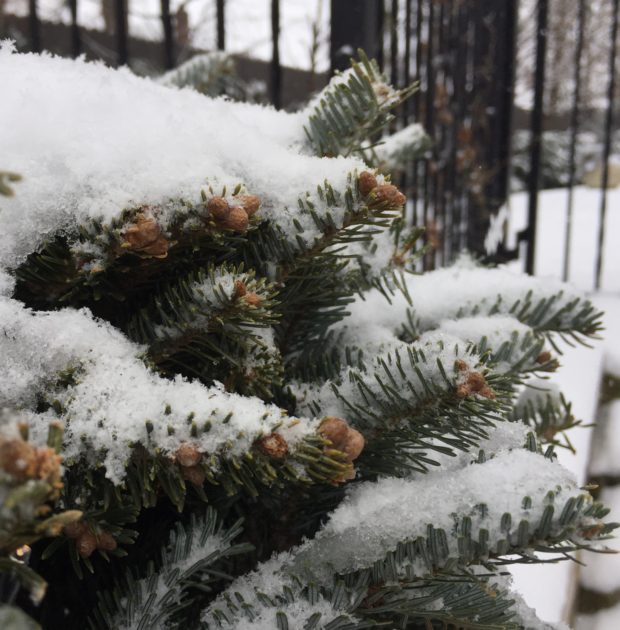 These evergreen Frazier fir boughs were cut in November. They were stuffed in to dry floral foam set in the containers I have at the end of my driveway. Though they were cut from the tree 3 months ago, the dormant buds are still plump, juicy, and viable. This is what I would call the miracle of the will to live. That will to live and prosper is so strong in every living thing. Nature makes the plant world, in all of its forms, possible. Viable.
These evergreen Frazier fir boughs were cut in November. They were stuffed in to dry floral foam set in the containers I have at the end of my driveway. Though they were cut from the tree 3 months ago, the dormant buds are still plump, juicy, and viable. This is what I would call the miracle of the will to live. That will to live and prosper is so strong in every living thing. Nature makes the plant world, in all of its forms, possible. Viable.
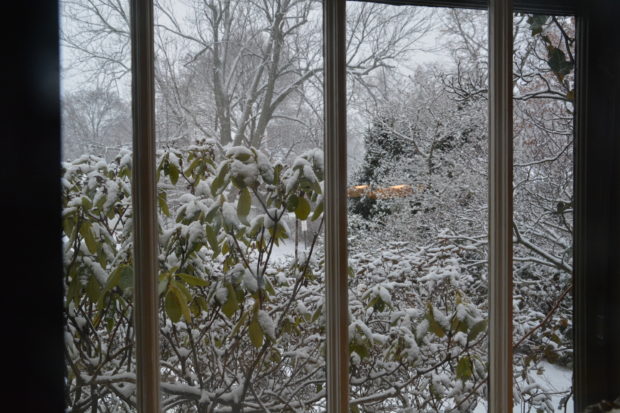 Though the view out my window is this shade of blah and that shade of blah, and all that blah dusted with a fresh layer of snow from grey skies, what lies in wait beneath the surface is very exciting, indeed. Waiting out the winter is an exercise in restraint and appreciation. Truly.
Though the view out my window is this shade of blah and that shade of blah, and all that blah dusted with a fresh layer of snow from grey skies, what lies in wait beneath the surface is very exciting, indeed. Waiting out the winter is an exercise in restraint and appreciation. Truly.